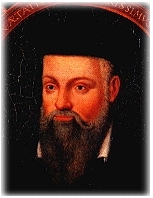The renowned prophet Nostradamus (Michel de Nostradame) was born on December 14, 1503
in St. Remy, Provence, France. Nostradamus came from a long line of Jewish doctors and
scholars. His family had converted from Judaism to Christianity in 1502, as a result of
persecution on the ascension of Louis the XII. After a classical education he studied
medicine, herbalism and astrology. During Nostradamus' lifetime the Black Death (today known as the bubonic plague)
wiped out over a quarter of Europe. It is no wonder that a sense of apocalyptic
terror fills Nostradamus' quatrains.
Nostradamus can indisputably be said to have been ahead of his time, at least in
terms of medical practice. His treatment of the Black Death involved removal of the
infected corpses, fresh air and unpolluted water for the healthy, a herbal preparation
rich in Vitamin C, and (in contravention of contemporary medical practise) not
bleeding his patients. Nostradamus was successful in lessening the impact of the Black
Death in the capital of Provence, Aix. The grateful citizens gave him a stipend for life.
Nostradamus began to write his prophetic verses in the city of Salon, in 1554.
They are divided into ten sections called Centuries (which refers to the number of
verses in each section, not to a unit of 100 years). The Centuries were published in
1555 and 1558, and have been in print continuously ever since.
Nostradamus had the visions which he later recorded in verse while staring into water
or flame late at night, sometimes aided by herbal stimulants, while sitting on a brass
tripod. The resulting quatrains (four line verses) are oblique and elliptical, and use
puns, anagrams and allegorical imagery. Most of the quatrains are open to multiple
interpretations, and some make no sense whatsoever. Some of them are chilling, literal
descriptions of events, giving specific or near-specific names, geographic locations,
astrological configurations, and sometimes actual dates. It is this quality of both
vagueness and specificity which allows each new generation to reinterpret Nostradamus.
Nostradamus is said to have predicted his own death. When his assistant wished him
goodnight on July 1, 1566, Nostradamus reputedly pronounced, "You will not find me
alive at sunrise." He was found dead on July 2, 1566. Nostradamus was interred standing u
pright in the Church of the Cordeliers of Salon. However, his story does not end there;
he was disinterred twice, once on purpose and once maliciously.
In 1700, his body was moved by the city to a more prominent crypt. When a necklace
was found on his skeleton bearing the date '1700', his body was hurriedly reinterred.
During the French Revolution, in 1791, some drunken soldiers broke into his tomb.
The mayor quickly placated the mob by describing how Nostradamus had predicted the
revolution, and they replaced the bones in the crypt. However, Nostradamus had the last
laugh. In Century 9, Quatrain 7, he had written:
The man who opens the tomb when it is found
And who does not close it immediately,
Evil will come to him
That no one will be able to prove.
Reputedly, the soldiers who desecrated his tomb for the final time were ambushed on
their way back to base. Every last one of them were killed.

